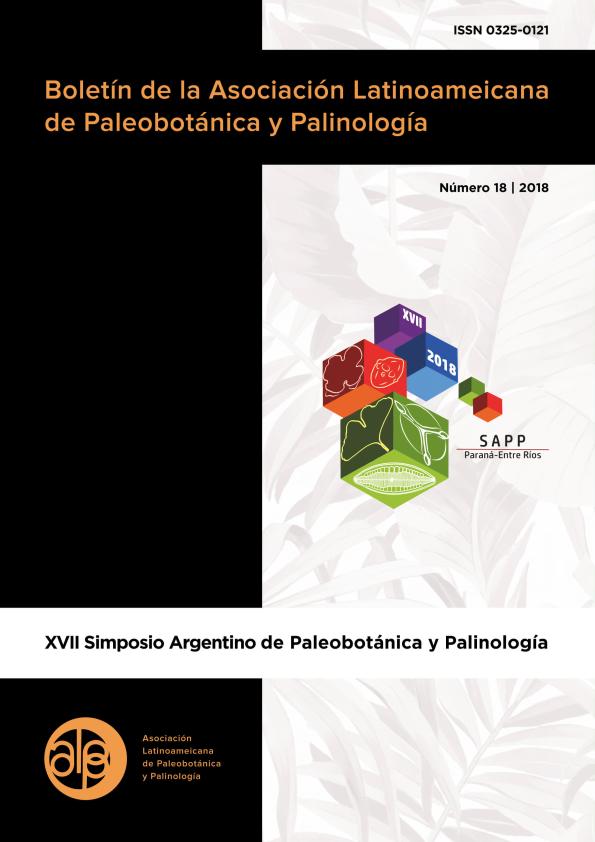Mostrar el registro sencillo del ítem
dc.contributor.author
Nuñez Otaño, Noelia Betiana

dc.contributor.author
Bianchinotti, Maria Virginia

dc.contributor.author
O'Keefe, J. M. K.
dc.date.available
2024-01-23T09:42:17Z
dc.date.issued
2018
dc.identifier.citation
Age is not a problem: using modern fungal taxonomy to increase accuracy
of deep-time paleoecological interpretations; XVII Simposio Argentino de Paleobotánica y Palinología; Paraná; Argentina; 2018; 151-151
dc.identifier.issn
0325-0121
dc.identifier.uri
http://hdl.handle.net/11336/224540
dc.description.abstract
Mycopalynology is an increasingly important branch of palynology. While the utility of fungi as ecological indicators has been known for nearly 100 years, it is only in the last two decades that fungi have been embraced by paleoecologists, in part because of the difficulty in classifying fungal taxa. Identification and naming of fossil fungi are not easy tasks. The traditional school follows the scheme of naming all fungi as if they were extinct, i.e. with names ending in-ites, etc. While useful for biostratigraphy, this method is not useful for paleoecology, especially if authors do not link fossil fungal remains named as form taxa to extant taxa. The most modern approach for naming fossil fungi is to follow the modern fungal taxonomic schemes. We present a re-study of three fossil fungal taxa (Desmidiosporites stellatus Elsik 1992 nomen nudum, Foveodiporites anklevarensis Varma & Rawat 1963 and Parapotamomyces maydiformis O Keefe 2017) as an example of how important the collaborative work between mycologists and palynologists is. Desmidiosporites stellatus, rather than being a variant of entomopathogenic Desmidiospora, could be a member of ?Arthrinium a group of endophytes, pathogens or saprobes, usually isolated from soil debris, plants, etc. Foveodiporites ankelvarensis is a member of a clade of soil-inhabiting fungi. Lastly, P. maydiformis is not allied to Potamomyces, as previously thought, rather it is a member of the Botryosphaeriaceae. Of note, all three taxa occur in the Eocene of Texas, Miocene of Peru, and Holocene of Argentina.
dc.format
application/pdf
dc.language.iso
eng
dc.publisher
Asociación Latinoamericana de Paleobotánica y Palinología
dc.rights
info:eu-repo/semantics/openAccess
dc.rights.uri
https://creativecommons.org/licenses/by-nc-sa/2.5/ar/
dc.subject
Mycopalinogy
dc.subject
Fungi
dc.subject
Fossil
dc.subject.classification
Micología

dc.subject.classification
Ciencias Biológicas

dc.subject.classification
CIENCIAS NATURALES Y EXACTAS

dc.title
Age is not a problem: using modern fungal taxonomy to increase accuracy
of deep-time paleoecological interpretations
dc.type
info:eu-repo/semantics/publishedVersion
dc.type
info:eu-repo/semantics/conferenceObject
dc.type
info:ar-repo/semantics/documento de conferencia
dc.date.updated
2024-01-19T10:17:52Z
dc.journal.pagination
151-151
dc.journal.pais
Argentina

dc.journal.ciudad
Buenos Aires
dc.description.fil
Fil: Nuñez Otaño, Noelia Betiana. Universidad Autónoma de Entre Ríos. Facultad de Ciencia y Tecnología; Argentina. Provincia de Entre Ríos. Centro de Investigaciones Científicas y Transferencia de Tecnología a la Producción. Universidad Autónoma de Entre Ríos. Centro de Investigaciones Científicas y Transferencia de Tecnología a la Producción. Consejo Nacional de Investigaciones Científicas y Técnicas. Centro Científico Tecnológico Conicet - Santa Fe. Centro de Investigaciones Científicas y Transferencia de Tecnología a la Producción; Argentina
dc.description.fil
Fil: Bianchinotti, Maria Virginia. Consejo Nacional de Investigaciones Científicas y Técnicas. Centro Científico Tecnológico Conicet - Bahía Blanca. Centro de Recursos Naturales Renovables de la Zona Semiárida. Universidad Nacional del Sur. Centro de Recursos Naturales Renovables de la Zona Semiárida; Argentina
dc.description.fil
Fil: O'Keefe, J. M. K.. Morehead State University; Estados Unidos
dc.relation.alternativeid
info:eu-repo/semantics/altIdentifier/url/https://www.palino.com.ar/alpp/BoletinesALPP/ALPP-boletin18-2018.pdf
dc.conicet.rol
Autor

dc.conicet.rol
Autor

dc.conicet.rol
Autor

dc.coverage
Nacional
dc.type.subtype
Simposio
dc.description.nombreEvento
XVII Simposio Argentino de Paleobotánica y Palinología
dc.date.evento
2018-07-30
dc.description.ciudadEvento
Paraná
dc.description.paisEvento
Argentina

dc.type.publicacion
Journal
dc.description.institucionOrganizadora
Asociación Latinoamericana de Paleobotánica y Palinología
dc.description.institucionOrganizadora
Universidad Autónoma de Entre Ríos
dc.source.revista
Boletín de la Asociación Latinoamericana de Paleobotánica y Palinología
dc.date.eventoHasta
2018-08-05
dc.type
Simposio
Archivos asociados
